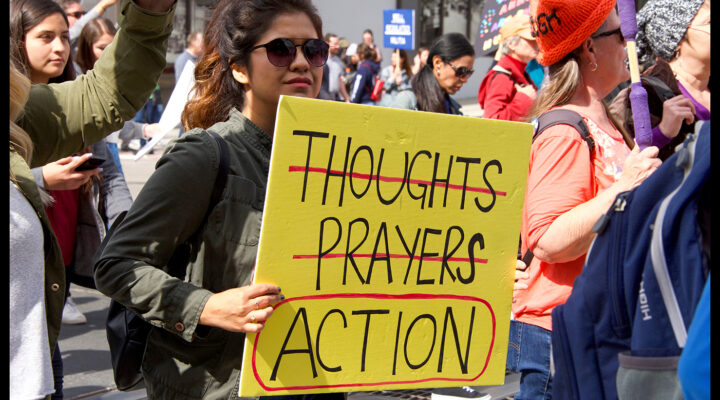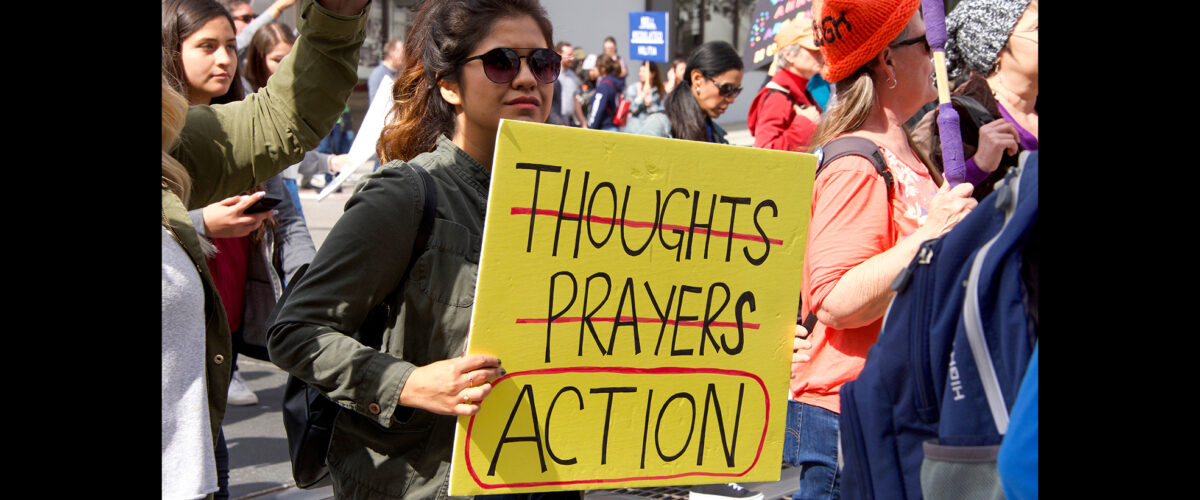There is a lot of discussion about gun violence after the mass shooting in Ulvade, Texas, and the alarming number of mass shootings across the United States. I suspect all of us have hurt deeply as the news of these needless deaths punches us in the gut.
We are in a gun violence epidemic.
Yet too much of the public response has been emotion-based, politicized name-calling.
Just the facts
To move beyond emotions, let’s start with some facts about gun violence and gun control in the U.S.:
- The science is abundantly clear: More guns do not stop crime.
- Guns kill more children each year than auto accidents.
- More children die by gunfire in a year than on-duty police officers and active military members.
- There is a common denominator in all this, the AR-15, a semi-automatic weapon used to murder innocent people in Tulsa, Uvalde, Buffalo, Boulder, Orlando, Parkland, Las Vegas, Aurora, Sandy Hook, Nashville, San Bernardino, Midland/Odessa, Poway, Sutherland Springs, Pittsburgh.
- Bullets from lower-caliber weapons typically pierce straight through a target while bullets from higher-caliber guns, such as the AR-15, can liquefy organs because of their much higher projectile speeds.
- You cannot rent a car until you are age 25, go to a casino until you are age 21, book a hotel room until you are age 21, purchase alcohol until you are age 21, be an Uber driver until you are age 21.
- The average firearm homicide rate in states without background checks is 58% higher than the average in states with background check laws in place. As of 2017, only 13 states had laws requiring universal background checks.
- When the U.S. had an assault-weapons ban from 1994 to 2004, mass shootings went down 43%. After the ban expired, mass shootings tripled.
- Nearly 5,000 more lives were lost to gun homicide in 2020 than in 2019. More than 1,200 people have been killed in mass shootings in the U.S. since 1996.
- From 1996 to 2012, the U.S. had six times its share of the world’s mass shootings (based on a study that included 171 countries).
- There have been 18 mass shootings (meaning four or more people killed) and 60 shootings in which three people have been killed in the U.S. so far this year.
- There were 45,222 gun deaths in the U.S. in 2020.
- 100 Americans a day die of gun homicide or suicide.
- Americans are 10 times more likely to be killed by guns than people in other countries of similar socio-economic status.
- At 4.5 per 100,000 people, the U.S. gun homicide rate is about eight times higher than Canada, 18 times higher than the United Kingdom, and 20 to 30 times higher than in Scandinavian Europe.
- Gun suicides remain at historically high levels. In 2020, 53% of all suicides were by firearm.
- Guns were the leading cause of death among children and teens in 2020, accounting for more deaths than COVID-19, car crashes or cancers.
- States with stronger gun laws have lower rates of gun violence.
A lesson from automobile safety
How do we change the trajectory of these trends? Consider what happened as a result of America adopting a comprehensive public health approach to automobile safety.
That comprehensive approach included allocation of funds to study the problem, empowering federal agencies to regulate car safety, requiring drivers to submit an application and pass a test to get a license, adopting laws against reckless and drunk driving, enacting age requirements.
“The U.S. reduced per-mile driving deaths by nearly 80% from 1967 to 2017.”
The result? The U.S. reduced per-mile driving deaths by nearly 80% from 1967 to 2017. Thus it seems possible that a comprehensive approach to gun violence prevention holds promise.
Yes, the U.S. has a long history of gun ownership. There are currently more than 393 million civilian-possessed firearms in this country. There are more guns than people in this country — 120 guns per 100 civilians.
And yes, the arguments around gun violence are not simply between those who own firearms and those who do not. Many gun owners believe there should be limits. Further, most who advocate for gun control measures do not envision making all firearms illegal.
The truth is, one can support both gun ownership and gun regulation.
Public opinion favors changes
The results of a recent Politico/Morning consult poll are compelling. There is strong support for gun regulation among voters: 88% strongly or somewhat support background checks on all gun sales, and 84% support preventing gun sales to people who have been reported to police as dangerous by a mental health provider. Also, 67% approve banning assault-style weapons like the AR-15.
This poll was done shortly after the mass shooting in Ulvade, and openness to gun control typically goes up immediately after such events. But the underlying point still stands — the overwhelming majority of Americans support some type of gun control.
I am not arguing against private gun ownership. I actually own guns — all from my earlier years of hunting. But as a friend of mine recently said, “I would turn them all in if I thought it would end gun violence.”
“With gun rights come grave responsibility.”
At the same time, I strongly support regulated gun ownership. With gun rights come grave responsibility. Again, in the interest of full self-disclosure, I have some sympathy with the argument that the Second Amendment cannot, in good faith, be interpreted to establish a right to individual gun ownership. Recall that former Chief Justice Warren Earl Burger recognized that view was fraudulent. Further, I am pragmatic enough to realize we likely never will move to a place of prohibiting individual gun ownership in this country.
What won’t work
Before we get to some simple proposals for change, let’s acknowledge there are some ideas being floated that simply will not work. For example, putting more guns in more hands will not stop the killing. We already have close to 400 million privately owned guns in the U.S.
Likewise, arming teachers is not a solution. This simply is not fair for teachers and would bring more problems. Having the calling and demeanor to be a good teacher does not mean one should have to, or even be able to, make split-second decisions when pointing a gun at someone else.
There is no single proposal that will solve our gun violence problem. The issue of gun violence is far too complex and needs to be addressed from a variety of perspectives.
“There is no single proposal that will solve our gun violence problem.”
And let us acknowledge there is no valid religious argument that it is our “God-given” right to carry a gun. That simply is not tenable.
Finally, doing nothing is not a solution either because that is our current failed strategy.
A proposal
I propose a multi-pronged framework that is based in science and reflects the will of the people. I do not propose a comprehensive solution, but rather a starting point — and for the most part, things we can do now:
- Enact a national ban on AR-15 and AK-47 assault weapons. These guns are meant primarily for one thing only, and that is to massacre people. They do this well, and there is no need for the average citizen to have access to them.
- Enact a ban on high-capacity magazines.
- Require and expand background checks.
- Raise the gun ownership age nationwide to 21.
- Create better gun permit laws with fewer loopholes.
- Adopt and enforce red-flag laws that take guns out of the hands of domestic abusers and people who abuse alcohol.
- Enact a waiting period for purchasing firearms (maybe to 21 days). This would address mass killings and suicide. A waiting period could help, given that the act of suicide is often impulsive. Further, there is evidence that copycat shootings often occur within 14 days of a mass shooting.
- Stop the proliferation of “ghost guns,” weapons manufactured with no serial numbers or tracking mechanism.
- Adopt well-regulated and comprehensive concealed gun carry laws but no open carry laws.
- Require gun owner licensing and education.
- Require safe and secure gun storage.
About mental health
Experts have said increasing mental health resources and making them more affordable could help reduce gun deaths, particularly suicides, but there is no fully effective mental health solution to stop mass shootings.
Less than 10% of shootings nationwide involve a suspect who has a mental illness, according to the National Alliance on Mental Illness.
Nevertheless, we need to strengthen mental heath services in this country. As part of a comprehensive, proactive response, schools should ensure that every adult in the system —teachers, bus drivers, coaches, janitors and cafeteria workers — understands warning signs of someone at risk of harming themselves or others and have systems in place to report potential threats.
We must do something
Most of the recommendations above seem reasonable to me, although I am sure not all will agree. Again, I am not opposing gun ownership. But I do propose that we have strong regulations as to who gets to own guns and the kinds of guns they get to own.
None of these proposals alone — and perhaps not even all of them combined — may stop mass shootings. But it is no longer acceptable to do nothing.
One recent study suggested gun-control measures could have prevented nearly one-third of mass shootings since 1999.
Are there other proactive measures to consider? Absolutely. I am open to consider them.
For now, we must try before others die.

Paul Robertson
Paul E. Robertson is a retired hospital chaplain and educator who currently lives in Sugar Land, Texas. He is a former professor of theology at New Orleans Baptist Theological Seminary and later became director of Clinical Pastoral Education and chaplaincy services at Memorial Hermann Health Care System in Houston. He is a graduate of Mississippi College and New Orleans Seminary, where he earned both the master of divinity degree and a Ph.D. in New Testament and Greek.


